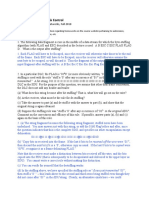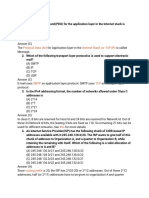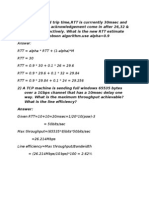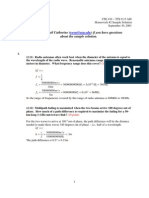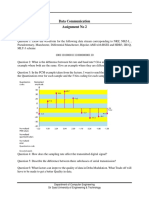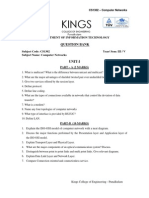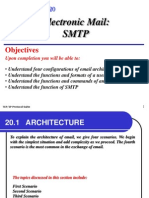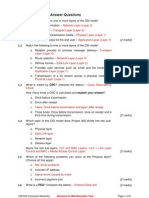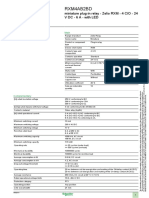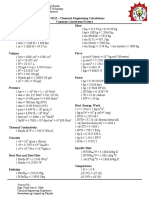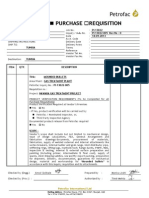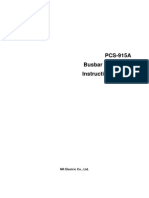Tutorial 04
Uploaded by
prettyswagTutorial 04
Uploaded by
prettyswagTutorial for Chapter 4
CEN 444 Computer Networks
Dr. Mostafa Dahshan
Department of Computer Engineering
College of Computer and Information Sciences
King Saud University
mdahshan@ksu.edu.sa
Last update: 30/12/2015
Tutorial for Chapter 4
Problem 1
Problem 1
Frames arrive randomly at a 100-Mbps channel for transmission. If the channel is
busy when a frame arrives, it waits its turn in a queue. Frame length is exponentially
distributed with a mean of 10,000 bits/frame. For each of the following frame arrival
rates, give the delay experienced by the average frame, including both queueing time
and transmission time.
(a) 90 frames/sec.
(b) 900 frames/sec.
(c) 9000 frames/sec.
M. Dahshan
CEN444 Computer Networks
Page 2 of 48
Tutorial for Chapter 4
Problem 1
Solution
The delay is calculated using the formula: = 1/( ).
Data rate = 100 106 = 108 bits/sec.
Mean frame length
= 10000 bits/frame. Thus =
1
10000
= 104 frames/bit.
Mean service rate = 104 frames/bit 108 bits/sec = 10000 frames/sec
(a) Arrival rate = 90 frames/sec. =
(b) Arrival rate = 900 frames/sec. =
(c) Arrival rate = 9000 frames/sec. =
M. Dahshan
1
1000090
= 0.0001009 0.1 msec
1
10000900
= 0.000109 0.11 msec
1
100009000
CEN444 Computer Networks
= 0.001 = 1 msec
Page 3 of 48
Tutorial for Chapter 4
Problem 2
Problem 2
A group of stations share a 56-kbps pure ALOHA channel. Each station outputs a
1000-bit frame on average once every 100 sec, even if the previous one has not yet
been sent (e.g., the stations can buffer outgoing frames). What is the maximum value
of ?
M. Dahshan
CEN444 Computer Networks
Page 4 of 48
Tutorial for Chapter 4
Problem 2
Solution
In pure ALOHA, the maximum throughput is 0.184.
Maximum usable bandwidth = 0.184 56000 bits/sec = 10300 bits/sec.
Each station requires
So, =
M. Dahshan
10300
10
1000 bits
100 sec
= 10 bits/sec.
= 1030 stations.
CEN444 Computer Networks
Page 5 of 48
Tutorial for Chapter 4
Problem 3
Problem 3
A large population of ALOHA users manages to generate 50 requests/sec, including
both originals and retransmissions. Time is slotted in units of 40 msec.
(a) What is the chance of success on the first attempt?
(b) What is the probability of exactly 5 collisions and then a success?
(c) What is the expected number of transmission attempts needed?
M. Dahshan
CEN444 Computer Networks
Page 6 of 48
Tutorial for Chapter 4
Problem 3
Solution
(a) = number of transmission + retransmissions per frame (slot) time
Slot time = 40 msec = 0.04 sec/slot. Number of slots per sec =
Frames transmissions = 50 frames/sec. =
50 frames/sec
25 slots/sec
1
0.04
= 25 slots/sec.
= 2 frames/slot.
Chance of success on first attempt 0 = = 2 = 0.135.
(b) The probability of a transmission requiring 1 collisions followed by success is:
= (1 ) 1
In this case, 1 = 5
6 = 2 (1 2 )5 = 0.0654
(c) The expected number of attempts = = 2 = 7.389
M. Dahshan
CEN444 Computer Networks
Page 7 of 48
Tutorial for Chapter 4
Problem 4
Problem 4
What is the length of a contention slot in CSMA/CD for:
(a) a 2-km cable (signal propagation speed is 82% of the speed in vacuum)?
(b) a 40-km multimode fiber optic cable (speed is 65% speed in vacuum)?
M. Dahshan
CEN444 Computer Networks
Page 8 of 48
Tutorial for Chapter 4
Problem 4
Solution
(a) Signal propagation speed = 0.82 3 108 = 2.46 108 m/sec.
Propagation time = =
Distance
Speed
2000 m
2.46108 m/sec
= 8.13 106 sec.
Length of contention slot = 2 = 2 8.13 106 = 16.26 106 sec.
(b) Signal propagation speed = 0.65 3 108 = 1.95 108 m/sec.
Propagation time = =
Distance
Speed
40000 m
1.95108
m/sec
= 205.128 106 sec.
Length of contention slot = 2 = 2 205.128 106 = 410.256 106 sec.
M. Dahshan
CEN444 Computer Networks
Page 9 of 48
Tutorial for Chapter 4
Problem 5
Problem 5
Consider the following the token passing protocol: When a host receives the token, the
host may transmit for at most 1 ms duration at the rate of 100 Mbps, and then pass the
token to the next host. Suppose that the time required to pass the token between
adjacent hosts is 0.05 ms. Assume that the token ring consists of 10 hosts.
a. Estimate the maximum aggregate ( )throughput achievable using the above
protocol.
b. Suppose that only one of the hosts on the token ring has a backlog () , and
no other host has any data to transmit. Determine the maximum throughput
achieved by the backlogged host.
M. Dahshan
CEN444 Computer Networks
Page 10 of 48
Tutorial for Chapter 4
Problem 5
Solution
a. Time for token to circulate around the ring is:
Token hold time no. of stations with data + Station transmit time no. of stations
= 1 ms 10 + 0.05 ms 10 = 10.5 ms
To maximize the aggregate throughput, each host should maximally utilize 1 ms for
transmission.
The aggregate number of bits that can be transmitted during this 10.5 ms period is:
1 ms 100Mbps 10 = 106bits.
The aggregate throughput = total number of bits / total transmission time
= 106 bits / 10.5 ms = 95.23 Mbps.
M. Dahshan
CEN444 Computer Networks
Page 11 of 48
Tutorial for Chapter 4
Problem 5
b. Since only one host is backlogged, only one host has data to transmit.
Time for token to circulate around the ring is:
Token hold time no. of stations with data + Station transmit time no. of stations
= 1 ms 1 + 0.05 ms 10 = 1.5 ms
The aggregate number of bits that can be transmitted during this period is:
1 ms 100Mbps = 105bits.
The aggregate throughput = total number of bits / total transmission time
= 105 bits / 1.5 ms = 66.67Mbps.
M. Dahshan
CEN444 Computer Networks
Page 12 of 48
Tutorial for Chapter 4
Problem 6
Problem 6
Consider five wireless stations, A, B, C, D, and E. Station A can communicate with all
other stations. B can communicate with A, C and E. C can communicate with A, B and
D. D can communicate with A, C and E. E can communicate A, D and B.
Show the steps of the MACA protocol until the frame is successfully transmitted.
Indicate which nodes must be silent during each step.
(a) When A sends a frame to B.
(b) When B sends a frame to A.
(c) When B sends a frame to C.
M. Dahshan
CEN444 Computer Networks
Page 13 of 48
Tutorial for Chapter 4
Problem 6
Solution
(a)
1. A sends RTS to B.
All stations hear the RTS, so they must stay silent until CTS
comes back.
A
B
C
D
E
A B
x
x
x x
x
x x
C D E
x x x
x
x
x
x
x
x
2. B sends CTS to A.
C and E will hear the CTS, so they must remain silent during the transmission of the
upcoming data frame.
D doesnt hear the CTS.
3. A sends data frame to B.
C and E are silent. D can transmit.
M. Dahshan
CEN444 Computer Networks
Page 14 of 48
Tutorial for Chapter 4
Problem 6
(b)
1. B sends RTS to A.
C and E hear the RTS, so they must remain silent until CTS comes back.
2. A sends CTS to B.
All stations hear the CTS, so they must remain silent during the transmission of the
upcoming data frame.
3. B sends data frame to A.
All stations are silent.
M. Dahshan
CEN444 Computer Networks
Page 15 of 48
Tutorial for Chapter 4
Problem 6
(c)
1. B sends RTS to C.
A and E will hear the RTS, so they must remain silent until CTS comes back.
2. C sends CTS to B.
A and D hear the CTS, so they must remain silent during the transmission of the
upcoming data frame.
E doesnt hear the CTS.
3. B sends data frame to C.
A and D are silent. E can transmit.
M. Dahshan
CEN444 Computer Networks
Page 16 of 48
Tutorial for Chapter 4
Problem 7
Problem 7
Six stations, A through F, communicate using the MACA protocol. Is it possible for
two transmissions to take place simultaneously? Explain your answer.
M. Dahshan
CEN444 Computer Networks
Page 17 of 48
Tutorial for Chapter 4
Problem 7
Solution
If they are in a straight line and that each station can reach only its nearest neighbors.
Then A can send to B while E is sending to F. So, the answer is Yes.
M. Dahshan
CEN444 Computer Networks
Page 18 of 48
Tutorial for Chapter 4
Problem 8
Problem 8
A 1-km-long, 10-Mbps CSMA/CD LAN (not 802.3) has a propagation speed of 200
m/sec. Repeaters are not allowed in this system. Data frames are 256 bits long,
including 32 bits of header, checksum, and other overhead. The first bit slot after a
successful transmission is reserved for the receiver to capture the channel in order to
send a 32-bit acknowledgement frame. What is the effective data rate, excluding
overhead, assuming that there are no collisions?
M. Dahshan
CEN444 Computer Networks
Page 19 of 48
Tutorial for Chapter 4
Problem 8
Solution
The effective data rate is calculated as:
The one-way propagation delay =
data length without headers
total time required to complete transmission
cable length
signal speed
1000 m
200 m/106 sec
= 5 106 sec
The round-trip propagation time of the cable =2
A complete transmission has six phases:
1. Transmitter seizes cable:
Required time is 2 = 10 106 sec
2. Transmit data:
Required time is
M. Dahshan
frame length
data rate
256
10106
= 25.6 106 sec
CEN444 Computer Networks
Page 20 of 48
Tutorial for Chapter 4
Problem 8
3. Delay for last bit to get to the end:
Required time is = 5 106 sec
4. Receiver seizes cable:
Required time is 2 = 10 106 sec
5. Acknowledgement sent:
Required time is
ack length
data rate
32
10106
= 3.2 106 sec
6. Delay for last bit to get to the end:
Required time is = 5 106 sec
Total time required = (10 + 25.6 + 5 + 10 + 3.2 + 5) 106 = 58.8 106 sec
Effective data rate =
M. Dahshan
25632
58.8106
= 3862068.96 3.8 106 bps
CEN444 Computer Networks
Page 21 of 48
Tutorial for Chapter 4
Problem 9
Problem 9
A switch designed for use with fast Ethernet has a backplane that can move 1 Gbps.
How many frames/sec can it handle in the worst case?
M. Dahshan
CEN444 Computer Networks
Page 22 of 48
Tutorial for Chapter 4
Problem 9
Solution
The worst case is an endless stream of 64-byte (512bit) frames.
The backplane can handle 109 bps
The number of frames it can handle is:
109
= 1953125 frames/sec
512
M. Dahshan
CEN444 Computer Networks
Page 23 of 48
Tutorial for Chapter 4
Problem 10
Problem 10
In the following figure, four stations, A, B, C, and D, are shown. Which of the last two
stations do you think is closest to A and why?
M. Dahshan
CEN444 Computer Networks
Page 24 of 48
Tutorial for Chapter 4
Problem 10
Solution
Station C heard the RTS and responded to it by asserting its NAV signal.
D did not respond.
Thus, C is the closest to A.
D must be outside As range.
M. Dahshan
CEN444 Computer Networks
Page 25 of 48
Tutorial for Chapter 4
Problem 11
Problem 11
Suppose that an 11-Mbps 802.11b LAN is transmitting 64-byte frames back-to-back
over a radio channel with a bit error rate of 107 . How many frames per second will
be damaged on average?
M. Dahshan
CEN444 Computer Networks
Page 26 of 48
Tutorial for Chapter 4
Problem 11
Solution
Let error probability per bit = 107
Probability of an -bit frame arriving correctly is = (1 )
Thus, probability of a frame arriving correctly is (1 107 )648 = 0.9999488
Probability of frame being damaged is (1 ) = (1 0.9999488) = 5.12 105
Data rate of 802.11b is 11 106 bits/sec
Number of frames transmitted per second is
11106 bits/sec
648 bits/frame
= 21484.375 frames/sec
No. of damaged frames/second = No. of frames/sec probability of frame damaged
= 21484.375 5.11986918 105 = 1.0999 1.1 frames/sec
M. Dahshan
CEN444 Computer Networks
Page 27 of 48
Tutorial for Chapter 4
Problem 12
Problem 12
Consider an 802.11 wireless LAN with the following parameters:
Physical layer data rate = 54Mbps
MAC layer data payload = 1452 bytes
MAC header = 28 bytes
ACK Frame size = 14 bytes
RTS length = 20 bytes
CTS length = 14 bytes
DIFS time = 34s
SIFS Time = 16s
MAC layer throughput is defined as the number of bits sent by the MAC layer in a
given period of time. Assuming that there are two stations exchanging a data frame
using 802.11 DCF and that the two stations are using RTS/CTS transaction.
M. Dahshan
CEN444 Computer Networks
Page 28 of 48
Tutorial for Chapter 4
Problem 12
a. Draw a timeline diagram describing this communication.
b. Calculate the required time for this communication.
c. Calculate the MAC layer throughput.
M. Dahshan
CEN444 Computer Networks
Page 29 of 48
Tutorial for Chapter 4
Problem 12
Solution
a.
M. Dahshan
CEN444 Computer Networks
Page 30 of 48
Tutorial for Chapter 4
Problem 12
b.
Total frame size = data size+ header size = 1452+28 = 1480 bytes
Data frame transmission time =
14808 bits
54 Mbps
ACK frame transmission time =
RTS frame transmission time =
CTS frame transmission time =
148 bits
54 Mbps
208
54
148
54
= 219.25 s
= 2.07 s
= 2.96 s
= 2.07 s
Total time required for transmission of one frame is:
Time of DIFS + RTS + SIFS + CTS +SIFS + Data + SIFS + ACK
34 + 2.96 + 16 + 2.07 + 16 + 219.25 + 16 + 2.07 = 308.35 s
M. Dahshan
CEN444 Computer Networks
Page 31 of 48
Tutorial for Chapter 4
Problem 12
c.
We are using 308.35 s to transmit 1452 bytes
MAC layer throughput is:
1452 8 bits
= 37.67 Mbps
308.35 s
M. Dahshan
CEN444 Computer Networks
Page 32 of 48
Tutorial for Chapter 4
Problem 13
Problem 13
In the previous problem, suppose that RTS/CTS transaction is not used.
a. Draw a timeline diagram describing this communication.
b. Calculate the required time for this communication.
c. Calculate the MAC layer throughput.
M. Dahshan
CEN444 Computer Networks
Page 33 of 48
Tutorial for Chapter 4
Problem 13
Solution
a.
M. Dahshan
CEN444 Computer Networks
Page 34 of 48
Tutorial for Chapter 4
Problem 13
b.
Total frame size = data size+ header size = 1452+28 = 1480 bytes
Data frame transmission time =
14808 bits
ACK frame transmission time =
54 Mbps
148 bits
54 Mbps
= 219.25 s
= 2.07 s
Total time required for transmission of one frame is:
Time of DIFS + Data + SIFS + ACK
34 + 219.25 + 16 + 2.07 = 271.32 s
M. Dahshan
CEN444 Computer Networks
Page 35 of 48
Tutorial for Chapter 4
Problem 13
c.
We are using 308.35 s to transmit 1452 bytes
MAC layer throughput is:
1452 8 bits
= 42.81 Mbps
271.32 s
M. Dahshan
CEN444 Computer Networks
Page 36 of 48
Tutorial for Chapter 4
Problem 14
Problem 14
Consider an 802.11 wireless LAN using DCF operation with the following parameters:
SIFS = 1 slot, DIFS = 3 slots, ACK = 1 slot, CWmin = 8, All Data frames = 4 slots.
There are four stations, S1, S2, S3 and S4.
At T = 0, S2 starts transmitting a Data frame to S3.
At T = 2, S1 has a Data frame to transmit to S4.
At T = 3, S3 has a Data frame to transmit to S2.
At T = 14, S4 has a Data frame to transmit to S2.
Assume backoff values, of S1 = 6, S3 = 3 and S4 = 1.
Draw a timeline diagram describing this communication. RTS/CTS are not used.
M. Dahshan
CEN444 Computer Networks
Page 37 of 48
Tutorial for Chapter 4
Problem 14
Solution
M. Dahshan
CEN444 Computer Networks
Page 38 of 48
Tutorial for Chapter 4
Problem 15
Problem 15
Store-and-forward switches have an advantage over cut-through switches with respect
to damaged frames. Explain what it is.
M. Dahshan
CEN444 Computer Networks
Page 39 of 48
Tutorial for Chapter 4
Problem 15
Solution
Store-and-forward switches store entire frames before forwarding them.
After a frame comes in, checksum can be verified.
If the frame is damaged, it is discarded immediately.
With cut-through, damaged frames cannot be discarded by the switch because by the
time the error is detected, the frame is already gone.
M. Dahshan
CEN444 Computer Networks
Page 40 of 48
Tutorial for Chapter 4
Problem 16
Problem 16
Consider the extended LAN connected using bridges B1 and B2 in the figure. Suppose
the hash tables in the two bridges are empty. List all ports on which a packet will be
forwarded and hash table updates for the following sequence of data transmissions:
(a) A sends a packet to C.
(b) E sends a packet to F.
(c) F sends a packet to E.
(d) G sends a packet to E.
(e) D sends a packet to A.
(f) B sends a packet to F.
M. Dahshan
CEN444 Computer Networks
Page 41 of 48
Tutorial for Chapter 4
Problem 16
Solution
Initially, the hash tables are empty.
Switches dont know which address is associated with which port.
B1
B2
Address
Port
Address
Port
M. Dahshan
CEN444 Computer Networks
Page 42 of 48
Tutorial for Chapter 4
Problem 16
(a) B1 will forward this packet on ports 2, 3, and 4. B2 will forward it on 1, 2 and 3.
Switch
From
To
Port
B1
1
B2
Updated hash tables:
B1
B2
Address
Port
Address
Port
M. Dahshan
CEN444 Computer Networks
Page 43 of 48
Tutorial for Chapter 4
Problem 16
(b) B2 will forward this packet on ports 1, 3, and 4. B1 will forward it on 1, 2 and 3.
Switch
From
To
Port
B1
B2
Hash tables are updated as follows:
B1
B2
Address
Port
Address
Port
M. Dahshan
CEN444 Computer Networks
Page 44 of 48
Tutorial for Chapter 4
Problem 16
(c) B2 will not forward this packet on any of its ports, and B1 will not see it.
Switch
From
To
Port
B1
1
B2
3
Hash tables are updated as follows:
B1
B2
Address
Port
Address
Port
M. Dahshan
CEN444 Computer Networks
Page 45 of 48
Tutorial for Chapter 4
Problem 16
(d) B2 will forward this packet on port 2. B1 will not see it.
Switch
From
To
Port
B1
1
B2
3
Hash tables are updated as follows:
B1
Address
A
E
M. Dahshan
B2
Port
1
4
Address
A
E
F
G
CEN444 Computer Networks
Port
4
2
2
3
Page 46 of 48
Tutorial for Chapter 4
Problem 16
(e) B2 will forward this packet on port 4 and B1 will forward it on port 1.
Switch
From
To
Port
B1
1
B2
3
Hash tables are updated as follows:
B1
Address
A
E
D
M. Dahshan
B2
Port
1
4
4
Address
A
E
F
G
D
CEN444 Computer Networks
Port
4
2
2
3
1
Page 47 of 48
Tutorial for Chapter 4
Problem 16
(f) B1 will forward this packet on ports 1, 3 and 4. B2 will forward it on port 2.
Switch
From
To
Port
B1
1
B2
3
Hash tables are updated as follows:
B1
Address
A
E
D
B
M. Dahshan
B2
Port
1
4
4
2
Address
A
E
F
G
D
B
CEN444 Computer Networks
Port
4
2
2
3
1
2
Page 48 of 48
You might also like
- LAB#05 Objective To Create An Arena Model Using Data Modules and Observe The Results of The Simulation Run Task #1No ratings yetLAB#05 Objective To Create An Arena Model Using Data Modules and Observe The Results of The Simulation Run Task #18 pages
- 6.2 Elements of Transport Protocols PDFNo ratings yet6.2 Elements of Transport Protocols PDF12 pages
- Unit-Iii: (Q) Explain Network Layer Design Issues? (2M/5M)No ratings yetUnit-Iii: (Q) Explain Network Layer Design Issues? (2M/5M)28 pages
- Medium Access Control Sublayer (Chapter 4) - CSHub PDFNo ratings yetMedium Access Control Sublayer (Chapter 4) - CSHub PDF15 pages
- Extra Problems On Chapter 2 (HTTP and FTP)No ratings yetExtra Problems On Chapter 2 (HTTP and FTP)10 pages
- Computer Network Unit 4 Transport LayerNo ratings yetComputer Network Unit 4 Transport Layer23 pages
- Cs9251 Mobile Computing 2marks 16marks Question PapersNo ratings yetCs9251 Mobile Computing 2marks 16marks Question Papers11 pages
- WIRELESS+AND+MOBILE+NETWORKING Seme2 2006No ratings yetWIRELESS+AND+MOBILE+NETWORKING Seme2 20062 pages
- OSI Seven Layers Model Explained With Examples100% (1)OSI Seven Layers Model Explained With Examples10 pages
- Cs 72 Mobile Computing 2 Mark Questions Unit I 1) What Are The Categories of Mobile Services?No ratings yetCs 72 Mobile Computing 2 Mark Questions Unit I 1) What Are The Categories of Mobile Services?20 pages
- Question 1 - Short Answer Questions: (2 Marks)100% (1)Question 1 - Short Answer Questions: (2 Marks)6 pages
- Expected Time: 90 Min Part-A Max Marks: 40No ratings yetExpected Time: 90 Min Part-A Max Marks: 404 pages
- NAME: - : Computer Networks I MID-TERM EXAM 2 - PART 2 (TOTAL: 5 Points) InstructionsNo ratings yetNAME: - : Computer Networks I MID-TERM EXAM 2 - PART 2 (TOTAL: 5 Points) Instructions5 pages
- AZURE Miami 1228: Unit Room Rules and RegulationsNo ratings yetAZURE Miami 1228: Unit Room Rules and Regulations1 page
- Am 5V Amplitude and The Specified Signal Frequencies Fmi Into The InputNo ratings yetAm 5V Amplitude and The Specified Signal Frequencies Fmi Into The Input1 page
- Am 5V Amplitude and The Specified Signal Frequencies Fmi Into The InputNo ratings yetAm 5V Amplitude and The Specified Signal Frequencies Fmi Into The Input1 page
- Born: Height: Nationality: Team: Manchester City (54, Goalkeeper)No ratings yetBorn: Height: Nationality: Team: Manchester City (54, Goalkeeper)3 pages
- Modification, Output Impedance Modification. We Were Also Able To Determine TheNo ratings yetModification, Output Impedance Modification. We Were Also Able To Determine The1 page
- 1MRK506074-UEN en Installation and Commissioning Manual REL 531 2.3No ratings yet1MRK506074-UEN en Installation and Commissioning Manual REL 531 2.3240 pages
- 02 HD785-7 Presentation For Pama All 06may1583% (6)02 HD785-7 Presentation For Pama All 06may1520 pages
- (HOW TO) Modification of AMD FB + Clover Injection - Page 14 - ATi - InsanelyMac ForumNo ratings yet(HOW TO) Modification of AMD FB + Clover Injection - Page 14 - ATi - InsanelyMac Forum13 pages
- Improvement of Through Thickness Properties of SSNo ratings yetImprovement of Through Thickness Properties of SS15 pages
- As 61508.1-2011 Functional Safety of Electrical Electronic Programmable Electronic Safety-Related Systems GenNo ratings yetAs 61508.1-2011 Functional Safety of Electrical Electronic Programmable Electronic Safety-Related Systems Gen12 pages
- Exxon IP 10-10-2 General Purpose Gear UnitsNo ratings yetExxon IP 10-10-2 General Purpose Gear Units3 pages
- IBM Security Qradar SIEM Implementation V 7 - C2150-400No ratings yetIBM Security Qradar SIEM Implementation V 7 - C2150-40027 pages
- APC122 - Technical Leaflet - V14 - CustomerNo ratings yetAPC122 - Technical Leaflet - V14 - Customer28 pages
- Phoenix Controls Laboratory Sourcebook 5th Ed.100% (1)Phoenix Controls Laboratory Sourcebook 5th Ed.90 pages
- LAB#05 Objective To Create An Arena Model Using Data Modules and Observe The Results of The Simulation Run Task #1LAB#05 Objective To Create An Arena Model Using Data Modules and Observe The Results of The Simulation Run Task #1
- Unit-Iii: (Q) Explain Network Layer Design Issues? (2M/5M)Unit-Iii: (Q) Explain Network Layer Design Issues? (2M/5M)
- Medium Access Control Sublayer (Chapter 4) - CSHub PDFMedium Access Control Sublayer (Chapter 4) - CSHub PDF
- Cs9251 Mobile Computing 2marks 16marks Question PapersCs9251 Mobile Computing 2marks 16marks Question Papers
- Cs 72 Mobile Computing 2 Mark Questions Unit I 1) What Are The Categories of Mobile Services?Cs 72 Mobile Computing 2 Mark Questions Unit I 1) What Are The Categories of Mobile Services?
- NAME: - : Computer Networks I MID-TERM EXAM 2 - PART 2 (TOTAL: 5 Points) InstructionsNAME: - : Computer Networks I MID-TERM EXAM 2 - PART 2 (TOTAL: 5 Points) Instructions
- Am 5V Amplitude and The Specified Signal Frequencies Fmi Into The InputAm 5V Amplitude and The Specified Signal Frequencies Fmi Into The Input
- Am 5V Amplitude and The Specified Signal Frequencies Fmi Into The InputAm 5V Amplitude and The Specified Signal Frequencies Fmi Into The Input
- Born: Height: Nationality: Team: Manchester City (54, Goalkeeper)Born: Height: Nationality: Team: Manchester City (54, Goalkeeper)
- Modification, Output Impedance Modification. We Were Also Able To Determine TheModification, Output Impedance Modification. We Were Also Able To Determine The
- 1MRK506074-UEN en Installation and Commissioning Manual REL 531 2.31MRK506074-UEN en Installation and Commissioning Manual REL 531 2.3
- (HOW TO) Modification of AMD FB + Clover Injection - Page 14 - ATi - InsanelyMac Forum(HOW TO) Modification of AMD FB + Clover Injection - Page 14 - ATi - InsanelyMac Forum
- As 61508.1-2011 Functional Safety of Electrical Electronic Programmable Electronic Safety-Related Systems GenAs 61508.1-2011 Functional Safety of Electrical Electronic Programmable Electronic Safety-Related Systems Gen
- IBM Security Qradar SIEM Implementation V 7 - C2150-400IBM Security Qradar SIEM Implementation V 7 - C2150-400

